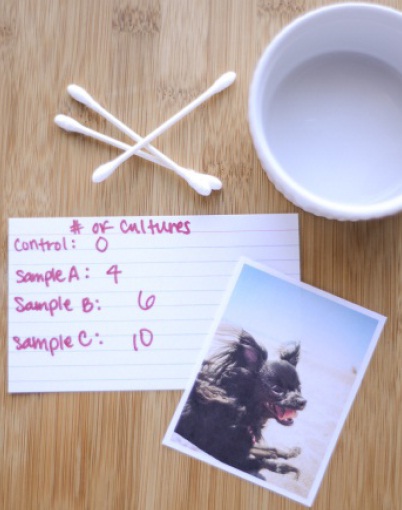





Published on Sep 12, 2023
There are many stories about injured hunters or pioneers who recovered from their injuries because wild animals licked their wounds. Such stories are not unique to the American West, but are common to many cultures. For example, the French have a saying “Langue de chien, langue de médecin,” which means “A dog’s tongue is a doctor’s tongue.” Even in our own modern society, the first thing we do when we get a paper cut is to put our injured fingers into the mouth. Is there any truth to these folktales? If an anti-bacterial effect is not observed, are there other benefits of wound-licking that could encourage healing?
Are there substances in saliva that kill bacteria?

1. 5 Petri dishes that contain sterile agar.
2. Fresh dog saliva (obtained from a pet such as a drooling mastiff or St. Bernard)
3. Freez e-dried staphylococcus epidermis bacteria (non-pathogenic)
4. Permanent marker for labeling Petri dishes. Sharpies are good for this!
1. Open one Petri dish and inoculate it with a few grains of the freez e-dried staphylococcus epidermis bacteria placed in different areas of the Petri dish. Pay close attention to exactly how much of the bacteria you use. Be careful not to use too much. Label this Petri dish as a control #1 and set it aside.
2. Open a second Petri dish and inoculate it with a ¼ teaspoon of dog saliva. Close the dish and label it as control #2.
3. Open a third Petri dish. Inoculate it with exactly the same amount of staphylococcus epidermis bacteria that you used in step #1. Follow this by topping the bacteria with a small amount of dog saliva. Cover the dish and label it as sample A.
4 . Pet your cat or dog. Run your hands through your hair. Rub your hands on the grass outside. In short, do something to expose your hands to germs. Carefully open one of the Petri dishes, and hold your hand flat against the agar for a few seconds. Cover the dish and label it Sample B.
5. Repeat step #4 . However, before closing the dish, add dog saliva to the areas you touched. Close the Petri dish, and label it with a permanent marker as Sample C.
6. Carefully put all the Petri dishes in an area where they will not be disturbed.
7. Inspect your dishes at 12, 24 , 36, and 4 8 hours. Compare Control #1 to Sample A. Are there more cultures growing in the dish that was inoculated with dog saliva? Compare Sample B to Sample C. Are there more cultures growing out in the dish that you touched or the dish that was touched and treated with dog saliva? Lastly, consider the number of cultures that grew out in Control #2. Can you draw any conclusions on the cleanliness of dog saliva?
The saliva of animals contains many agents that kill germs and help heal wounds. A few of these agents include:
• The enzyme lysoz yme, which breaks the chemical bonds in bacterial cell walls.
• The antibody IgA (immunoglobulin A), which directly attacks bacteria.
• Peroxidases, which help plants defend against bacteria.
• Opiorphin, which has an analgesic (pain killing) effect.
Other possible agents in saliva that aid the healing process include nerve growth factors (not found in humans, but present in mice), epidermal growth factor, hyaluronan, and others. Given all these factors, it is not surprising that saliva can exert a healing effect. Students should be able to observe that fewer cultures grow out in both of the dishes inoculated with dog saliva. If students don’t obtain the expected result, help them think through an explanation. Did the dog eat just before the drool was obtained? Consider other factors such as the mechanical effect of licking. While there is not an effective way of stimulating this in a Petri dish, licking may clean an injured area and remove germs. However, there are some possible negative effects of animal saliva as well. Sometimes excessive licking can irritate wounds. Saliva can also bring new germs to the injured area, particularly if the animal is sick. As shown by Control #2 in the experiment, dog saliva also has germs of its own.
• Saliva contains many different chemicals
• Antibodies (immunoglobulins) recogniz e foreign proteins in your body and attack them.
• Enz ymes speed some chemical reactions. Some of these reactions include breaking chemical bonds that hold the bacterial wall together
• Inoculate means expose an agar culture with bacteria or other agents.
Wikipedia article on microwaves